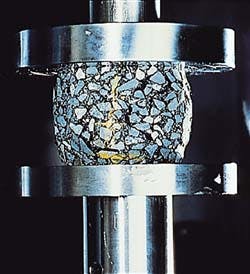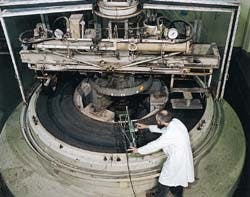Asphalt under compression test (photo at left) in Shell's laboratory at Grande Couronne, France. Demand for lower binder content in road building asphalt is making choice of bitumen critical. Use of polymer-modified bitumen increases the cost of road building by 10-15%, but this outlay is more than recovered through reduced maintenance costs. Asphalt test rig (photo below) at Shell's Amsterdam laboratory. Asphalt is laid in a shallow circular trough, around which a wheel is rolled to simulate road conditions. By laying asphalt from a number of different batches in sections of the trough, Shell can perform comparative tests to reveal vulnerability of different asphalt mixes to rutting and cracking. Photos courtesy of Shell.
Shell International Oil Products BV has developed its range of polymer modified bitumens (PMBs) to reduce maintenance costs at a time when use of such products in road building is taking off.
Gerard Heimerikx, manager of research in elastomers at Shell Chemicals' Amsterdam research center, explained that Shell's PMBs typically involve a mixture of 5-12% styrene-butadiene-styrene block copolymers with bitumen.
The resultant PMBs have notable elastic recovery, with elongation of 15-20 times possible with full recovery of original shape. Such products find applications where heat expansion and contraction is a problem.
Roofing applications
Heimerikx said roofing felt has been the major application for Shell PMBs so far.There can be problems with loss of shape of conventional materials when, for example, rain follows strong sunshine. On flat roofs, a material with elastic recovery can prevent water accumulation. Conventional bitumen does not have comparable thermal expansion.
"Polymer-modified systems were first developed in the late '60s and early '70s," said Heimerikx. "There is an increasing trend to use PMB rather than the competing oxidized bitumen, except where labor costs are (already) low. Labor costs are lower for PMB, because typically two layers are required compared with four for oxidized."
Heimerikx said latest PMB product developments include a reduction in the number of layers to be applied from two to one, thus reducing labor costs even further.
Use of fillers has also enabled viscosity of PMB grades to be reduced by as much as 40% compared with earlier grades. Calcium carbonate is a typical filler, which may form as much as 30% of the final mix depending on required viscosity.
Roofing-felt manufacturers usually buy bitumen from a local supplier and polymers from a specialist manufacturer to mix their own products.
There is considerable rivalry among roofing felt manufacturers, said Heimerikx, and demand for good performance of products for at least 20-25 years.
Tom Blanken, department manager for bitumen product development, said polymer modification of bitumen first began for road-building applications.
"At first roads didn't need it, and it was too expensive," said Blanken, "so Shell shifted its efforts to the non-paved market. Here, polymers, which are 20 times more expensive than bitumen, have been a big commercial success.
Road surfacing
"Now we are coming back to the roads market. In Europe many roads need modification, and now transport authorities can afford PMBs. There is a need for better bitumen mainly because of increasing traffic intensity."Increasing axle loads on heavy-duty vehicles and increasing tire pressure increase the risk of rutting in road surfaces. The risk increases as average vehicle speeds decline through traffic congestion.
Blanken said key requirements for future asphalt road surfaces are high deformation resistance, high noise reduction, and high durability as determined by both cracking resistance and stone retention.
A growing trend is towards laying of drainage asphalt, which is intended to throw up less spray in wet driving conditions.
In drainage asphalt, there are more stones and less bitumen than a conventional mix, so water can drain away. This reduction in bitumen content puts a greater emphasis on its performance.
These tougher asphalt requirements are being met by improved bitumens and increasing use of high-performance bitumen binders in the asphalt mix. PMBs contain 3-15% polymer for various road applications.
Blanken expects legislation for low-spray road surfaces to drive the market for PMBs. He cited a declaration by the Netherlands government that all Dutch roads should be paved with drainage asphalt by 2005. Other European countries are expected to follow suit.
"Life-cycle costing of roads is now helping introduction of PMBs because of their lower maintenance costs," said Blanken. "PMBs give the same rut depth over 15 years as standard asphalt used to 20 years ago, when road use and load sizes were lower."
Copyright 1997 Oil & Gas Journal. All Rights Reserved.




